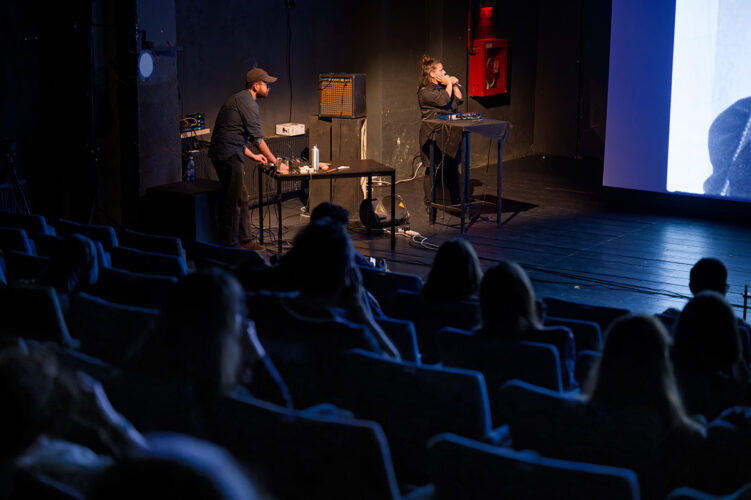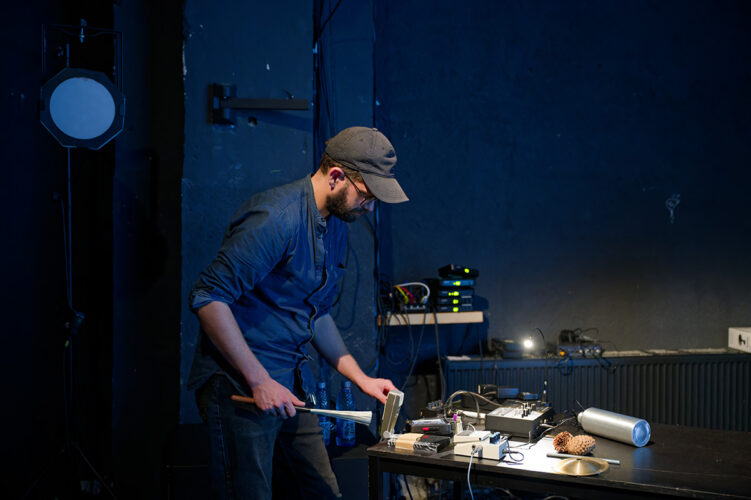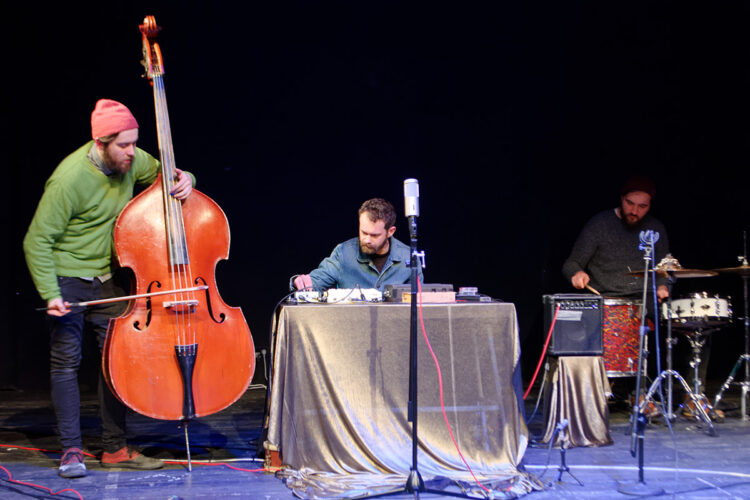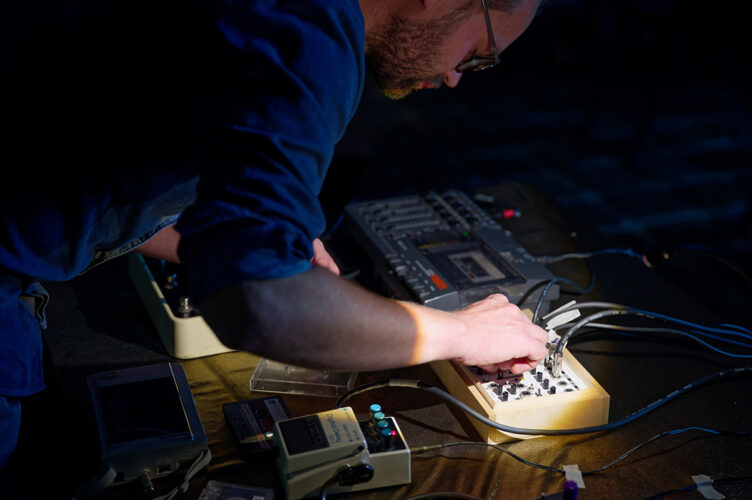Dan Michiu is an experimental musician who dropped out of his guitar classes and decided to learn everything from scratch, as if he had invented the electric guitar. With a small amount of knowledge, he learned and is still learning to play every time he touches a guitar, to which he adds effects pedals, sometimes altering the sound so much that the sound becomes unrecognizable. At the moment he is active in several projects where he deals with the experimental side of the sound, either by adding synthesizers or radios. On one of his solo records, “New Emulsions “, for example, it’s all based on altered tapes through tempo changes, (un)controlled delays or other “tricks” that you’ll learn about below, but also on digital synthesis elements, many in the area of prepared objects. He also works with image and sound, often in projects to restore old movie productions and create new soundtracks for them. Self-taught in the electronic side of things, Dan also has his own DIY label, where he releases the various collaborations he takes part in, as well as many other albums by artists from all over the world, from the United States (Zach Rowden) to Indonesia (Senyawa), and of course Romania. It’s a pleasure to chat with him and in the following you’ll learn more about Dan Michiu, especially since the artist is full of surprises.
When did you start this whole music thing? Did you study music or did you learn it all on your own? Which artists influenced you the most?
Neither of my parents necessarily played, I wasn’t one of those kids with a piano in the house although I was fascinated by pianos, when I was a kid I went to visit friends or museums and I was drawn to big instruments but I had records at home, I listened to them, most of which I didn’t come to appreciate until my adolescence. Pink Floyd’s “Careful with that axe, Eugene”, for example, that was my first experience with experimental sounds, that was the trigger, even though I was quite small, I was about 5-6 years old. I randomly played the album “Umagumma”, I got to the track and had a little bit of a culture shock that something like that had been released and that this kind of art or expression existed. My father didn’t study music, but architecture, and he was friends, for example, with Dorin Liviu Zaharia, from “Olimpic ’64”. My father was quite passionate about music, so there are still some important records from that period, which aroused my curiosity. Then, when I started looking for and listening to music on my own as a teenager, hip-hop was it. Both American, and Romanian, and a bit French, it was more accessible back then, after ’90. There was also this experimental aspect, for example with Getto Dacii, Methadon3000, Deceneu or Vexxxatu’ Vex (now Norzeatic, ed.). They were not necessarily underground, but produced by big record labels like A&A Records or Cat Music. The only way to get to the artists was through the Hollywood music & film, where you could get pretty much anything. I was also listening to a lot of American hip-hop: Wu-Tang, Cypress Hill, 36Mafia. So that was the order: hip-hop at the beginning and then, more gradually, punk, electronic music and other genres. In Bistrița I had older friends who made compilations, death metal, black metal was very popular in the underground scene, but there were some people who listened to British trip-hop like Massive Attack or Goldie, more on the side of jungle, drum and bass, or Portishead. There were a lot of sectors that were very into certain areas of music, even in a small town. I even had a fine arts teacher who lived at school and he’d come in with a whole collection of CDs and tapes and I’d pull everything I could get my hands on: The Clash, Sex Pistols, Black Sabbath, I had complete discographies but also bootlegs. My interest in playing came when I was 13-14 when I started to learn classical guitar, I took lessons for 4 years and then I improvised by myself because I thought it was more important to be self-taught. It was only when I arrived in Bucharest that I slowly started to learn electric guitar. I realized from the start that it was an instrument especially when effects and sound processing pedals came out. Feedback was my first revelation on the electric guitar, then delay, reverb, the classics. This is where the exploration started, especially after I started playing with various other people and discussing, discovering, learning, trying to develop a language. Even though a lot of things have already been done with the electric guitar or with prepared objects that produce sounds, there are still many new possibilities of expression, depending on one’s approach.
You are basically an improviser and it seems to me this somehow defines your compositions. How do you prepare for a gig? What effects do you use, what’s the setup? I’m referring in particular to what you’ve been working on with the Billa Ensemble.
Technically it’s not that complex for me, it’s a guitar, an amp and maybe in this whole setup I may add 2-3 effects pedals or more amps. It all varies from project to project. The basic pedals are a delay and equalizer and/or distortion or a wah-wah pedal, of which I have a couple. My setup is simple and basic because I’ve learned over time to stay out of trouble on the effects chain. For example, for the recordings with the Billa Ensemble (Marie Vermont, the concept horse, Michiu, Turmeric Acid), I had a sort of small, baby electric guitar that I took on tour so I wouldn’t have to carry too much. I’ve traveled to Bucharest, Cluj, then the Czech Republic and Vienna, I took the train carrying a delay and a bass head and a 150-watt amplifier with a rigid and practical equalizer on it. I’m thinking of using made-up or radically adapted guitars in the future. I’m not sure what the end result will be, but I’m thinking a four-string, amplified, Merzbow-style fretboard.
How do you use the magnetic tape? Do you loop or is it more complicated than that? I’m especially referring to the track “New Emulsions”, which I think is one of your “loudest” tracks.
In short, my experiments are not very complex. Basically I either work with found, deteriorated tapes, which offer some surprising sonorities that you can’t get through digital processing. I work a lot with loops and collages, everything with found tapes or magnetic tape, I use a lot of loops, either four-channel or on a modified walkman that has speed control or damaged tape. I also use other sound sources, synthesizers or percussion recordings, object recordings, either with contact microphones or using tape recorder microphones which are inherently more lo-fi. I use various sounds recorded directly on the cassette recorder; these small ones are very rewarding if they have speed control.
Somehow, for me, the main instrument seems to be the electric guitar, but on the record released by Muhoi, a Hong Kong label, the legendary Korg MS-20 synthesizer and the guitar play the main role. The MS-20 is also my favorite synthesizer, by the way, for all my needs. Otherwise I still have a yellow Kaossilator and a few gadgets. I also have a Volca Bass and a Monotribe. I also use some small Casios and other keyboards. I record a lot and use the bits I like. I’ve also played in more conventional bands, rock bands if you like, but I’ve always been interested in this experimental area. Guitar at first, then I added little electronic elements, radios, strange frequencies. AM or FM frequency noise is very expressive and I like to include it in my experiments. Empirically, I use the feedback I get from the instrument, usually a guitar.
How do you approach a silent film when you compose its soundtrack with Abator Industries, a joint project consisting of Andreea Tincea, Cătălin Lungu, Daniel Iliescu and yourself? You have already worked on more than 10 movies.
It’s a pretty simple approach, we watch the movie and we establish some moments, but otherwise it’s very much free improvisation. We try to be sensitive, attentive to what’s happening in the film, but we realize that it’s a live performance, not necessarily a soundtrack, and we take some liberties. The rest is up to the audience. The rest is left to the imagination. For example, technically, we watch the movie and decide on some instruments we want to use. For Abator Industries, the setup usually varies, sometimes there is a voice (Andreea Tincea) or electric guitar. Andreea runs her voice through all kinds of effects and processes it in real time, you often don’t even realize it’s a human voice.
What was the most challenging soundtrack you made with Abator Industries?
I think Fritz Lang’s Metropolis. It was a challenge compared to other films because it’s also quite fast-paced, more action-driven than others. For Nosferatu, it was a pleasure and there’s a lot of freedom because it has an atmosphere that you can interpret however you like. You can build much more freely and loosely and transition from moment to moment more fluidly than in other movies.
How is your label, Beach Buddies Records, going? How do you decide on what to release and which one of your tapes was the most succesful?
The Beach Buddies Records label started as an activity to keep and maintain relationships with bands, musicians, projects that I have a personal relationship with. The label started at the very beginning of the pandemic, when there were no opportunities to travel, to play live, and it was a very practical way to keep in touch with the underground scene. Fortunately, the label is self-sustaining because I’ve made quite a lot of connections and some have various distros (distribution channels), some are active on Bandcamp, quite loyal. Most of the buyers are from Japan, Canada, USA, Europe, and a few from Romania. If I like the music and it stimulates me in some intellectual or emotional way, I release it. The approach matters a lot. The label started as an excuse to archive local musicians as well, to bring some variation.
Our most succesful cassette: the Alkisah album by Senyawa, edited together with Orgone Dealers, a record released as part of an extended network of music labels from around the world, and the more recent tape by Lorenzo Gomez Oviedo from Argentina. Laurențiu Coțac’s album was quite popular as well, same with Somnoroase Păsărele. In any case, it’s not a competition.
Which label is your favorite and why? Tell us a bit about the do-it-yourself cassette scene in Romania and the region. Beyond the music, there are releases that come with special cover designs, sometimes by established visual artists, or even artworks and special cassette cases for collectors.
There are so many labels but, if I were to chose what inspires me, locally I really like Orgone Dealers and Institutul Cristea. As for the international scene, I am most inspired by Post Materialisation Music or American Tapes. I generally like labels driven by the idea of independence and discovering new sounds. I like to find people I have something in common with in a global context, even if it’s in Japan or China for instance: we share a common thread in the music we listen to, the books we read or the movies we watch, etc.
You have collaborated with many local artists so far, ranging from Raul Starcz to Gili Mocanu. Who else within the Romanian scene would you like to work with?
I’ve worked with many but I never plan any collaboration. If the context arises, something will definitely happen. An EP that came out on cassette, as well as digitally, the Bebino project (with Alin Cincă from Bastos on drums), is called Freedoom. Several future collaborations are already in the works, oriented around this studio called “Common Good”. One of these, together with Alin, features lap-steel guitar and a Farfisa organ, and is called Omida. I also work well with Laurențiu Coțac. “Common Good’ works as a kind of common space for some of the artists in the network, people who share a common ethos, not founded on success but rather on the love of music.
POSTED BY
Miron Ghiu
Obsessed with new technology and a close manipulator of all sounds, Miron Ghiu lives in a continuous present. He enjoys bathing online and hanging out offline, surrounded by loads of buttons to press ...
mironghiu.wordpress.com








Comments are closed here.